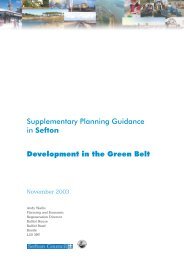The impact of sand extraction at Formby Point ... - Sefton Council
The impact of sand extraction at Formby Point ... - Sefton Council
The impact of sand extraction at Formby Point ... - Sefton Council
Create successful ePaper yourself
Turn your PDF publications into a flip-book with our unique Google optimized e-Paper software.
14<br />
1961. <strong>The</strong> 1945 aerial photo shows th<strong>at</strong> <strong>sand</strong>-winning invaded this area but evidence on<br />
the ground has been obscured by l<strong>at</strong>er accretion. About 100m north <strong>of</strong> the Rifle Range<br />
boundary is an enclave <strong>of</strong> lower-lying land extending about 100m westwards and<br />
probably representing an old <strong>extraction</strong> site. Except for some low semi-fixed, ridges, this<br />
area is now largely covered with Creeping Willow. One deeper basin (slack 28) was<br />
excav<strong>at</strong>ed as a small N<strong>at</strong>terjack Toad scrape in 1988 and repr<strong>of</strong>iled in 2005. <strong>The</strong><br />
shallow central area has been colonised by Common Spike-rush (Eleocharis palustris)<br />
and W<strong>at</strong>er Horsetail (Equisetum fluvi<strong>at</strong>ile), while the dryer surrounds support a rich plant<br />
community, including Small-fruited Yellow-sedge, marsh orchids, Grass-<strong>of</strong>-Parnassus,<br />
Seaside Centaury, Knotted Pearlwort, etc. Another, larger, slack basin to the south (slack<br />
26) is mostly domin<strong>at</strong>ed by tall Creeping Willow but, around the margins, it has Marsh<br />
Helleborine, marsh-orchids and the n<strong>at</strong>ionally scarce Round-leaved Wintergreen, the<br />
l<strong>at</strong>ter in some abundance.<br />
To the east is a large enclosure winter-grazed by Herdwick sheep and year-round by<br />
Rabbits. Most <strong>of</strong> this plot has a more-or-less level topography with extensive Creeping<br />
Willow. Slightly higher ground supports a sward <strong>of</strong> Red Fescue and Marram with much<br />
Dewberry. Small, sc<strong>at</strong>tered, bare p<strong>at</strong>ches are associ<strong>at</strong>ed with Rabbit activity but sheep<br />
do not seem to have had much effect on the substr<strong>at</strong>e. <strong>The</strong> Dune Helleborine has been<br />
recorded as “local” on fixed-dunes within the reserve (English N<strong>at</strong>ure 2004) but was not<br />
observed during my visits. <strong>The</strong>re is a sc<strong>at</strong>tering <strong>of</strong> larger willows, mainly Grey Willow,<br />
but also many bushes <strong>of</strong> Salix x friesiana and one or two th<strong>at</strong> may be S. x angusensis. A<br />
small plot, fenced to exclude livestock, is heavily colonised by large willows. <strong>The</strong><br />
frequency <strong>of</strong> willow bushes increases near to the main borrow-pit, this being one <strong>of</strong> the<br />
gre<strong>at</strong>est concentr<strong>at</strong>ions on the <strong>Sefton</strong> coast <strong>of</strong> rare willow hybrids, including about 50<br />
bushes <strong>of</strong> Salix x friesiana. Adjacent to the borrow-pit are two large (c. 1ha) wet-slack<br />
basins, numbered 2 and 20 by Smith (1978a). No. 20 supports an important popul<strong>at</strong>ion <strong>of</strong><br />
Fl<strong>at</strong>-sedge and a number <strong>of</strong> willows, including a single Purple Willow (S. purpurea), one<br />
bush <strong>of</strong> S. x doniana, 18 <strong>of</strong> S. x friesiana and also a Bay Willow (S. pentandra) which,<br />
although not notable, is rare in the dunes.















